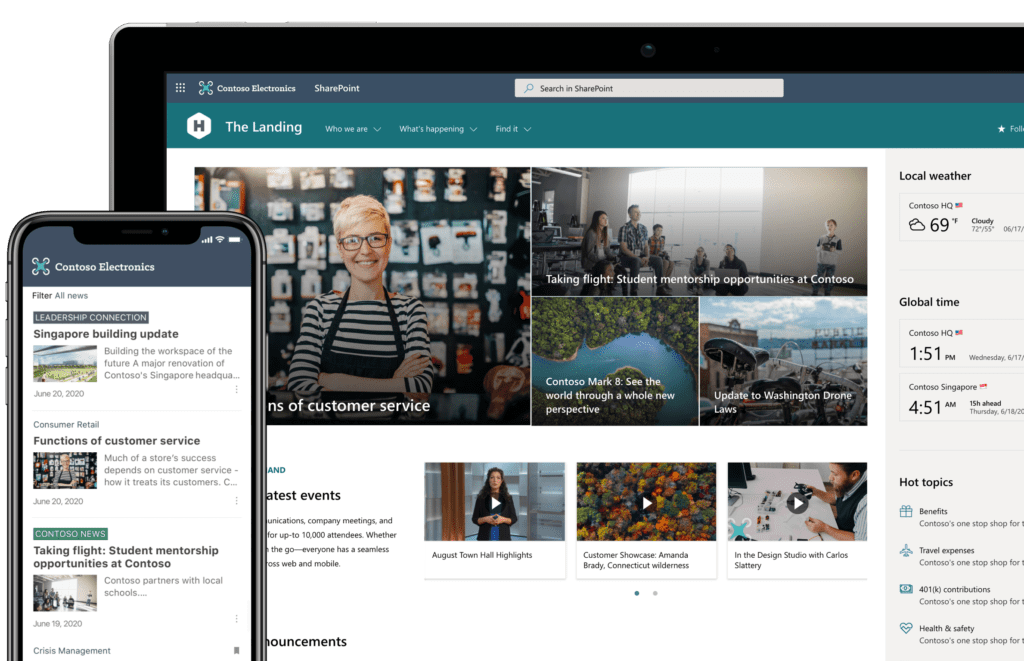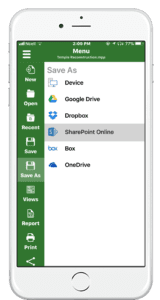While SharePoint appears a mystery to most normal folk, this enterprise system software from Microsoft has sold over one hundred million licenses since 2001, is estimated to be adding 20,000 new users every day, and is deployed by eight in 10 companies ranking in the Fortune 500.
You might already be familiar with the functionality of SharePoint, which focuses on these core areas:
- Content management;
- Knowledge management; and
- Application delivery.
For example, SharePoint is used within organizations to:
- Build intranets and/or individual team or workgroup websites;
- Better enable collaboration and knowledge sharing within the enterprise; and
- Deliver applications across the enterprise, such as Microsoft Project Server.
In short, SharePoint is a collaboration tool, content management system and software development platform — all rolled into one!

A sample intranet homepage created with Microsoft SharePoint
The Evolution of SharePoint
SharePoint came about during the Microsoft Windows XP days, back in 2001. That’s when office applications and Exchange’s email was first being integrated into large-scale enterprise networking, hence the “sharing” part of the SharePoint moniker. It was also Microsoft’s first “portal” solution for its enterprise customers. If you can recall, portals — web-based interfaces to various applications and information — were all the rage at the time.
Subsequent releases of SharePoint loosely followed releases of Microsoft Office. For example, after Office 2003 and Office 2007 were released, new versions of SharePoint included improvements and features, such as better indexing of enterprise content (think networked files) and the ability to personalize the framework that held all that indexed content.
This leap-frogging continues to this day, with important Microsoft tools being added to the framework with each new release. For example, in 2006 we saw the inclusion the Business Data Catalog and InfoPath Form Services.
But important to project managers around the globe, after 2010, we also see the integration of Microsoft Project Server, and the release of the Project Web App (PWA) that works on top of the SharePoint platform.
PWA allows you to share your project files, analyze project portfolios and create global timesheets for work. This app also allows for worldwide updating of tasks, no matter where the resources assigned to the tasks are located.
The Importance of SharePoint Today
Since 2016, SharePoint has taken on a much wider role in the Microsoft ecosystem of products. SharePoint has become integrated with the cloud, and with the Office 365 suite of products. That means that SharePoint is not only used to underpin the sharing of your project data, but all other types of Office data as well, to those inside and out of your enterprise.
In another exciting turnabout for SharePoint, third-party hosting providers now provide SharePoint access to those not wealthy enough to acquire all the on-premises software requirements — for a monthly subscription rate, instead of a huge capital investment. (Installations of SharePoint with all its requirements, can easily exceed $100,000 for a small to mid-size business.)
Third-party apps now save to SharePoint systems! To the left, Project Plan 365 is shown.
In addition, SharePoint’s visibility is now being raised to the common user, as more device apps include a SharePoint click under “Save as,” allowing you to store your app files to a SharePoint repository, just as you would, say, store your files on Dropbox or Google Drive.
Yet with all this newfound popularity comes some criticism. In a recent report relevant to those installing SharePoint in-house, Gartner noted, “Most organizations underestimate SharePoint’s maintenance and service costs. These can be two or three times more than the initial license price, once add-ons are deployed.” This price-point problem has been a boon for the competition, with the likes of Interact, Huddle and others scrambling to fill a lower-cost space.
But for the modern project manager, SharePoint remains an integral component of our enterprise project management toolbox and will, no doubt, provide even more useful and improved PM tools going forward.



